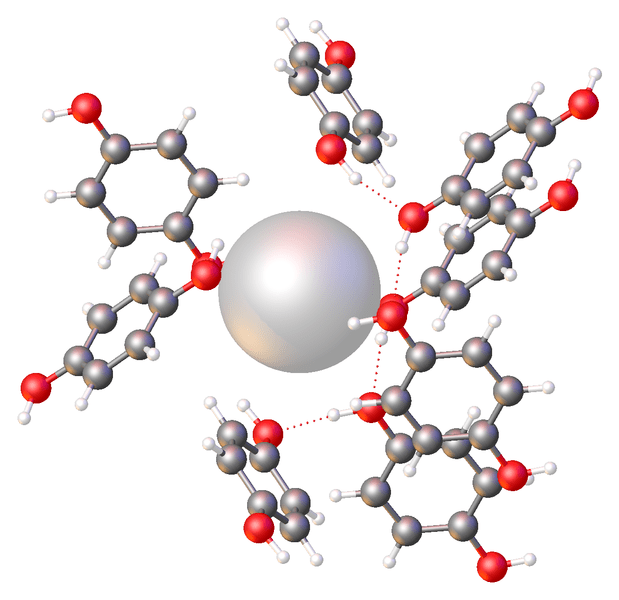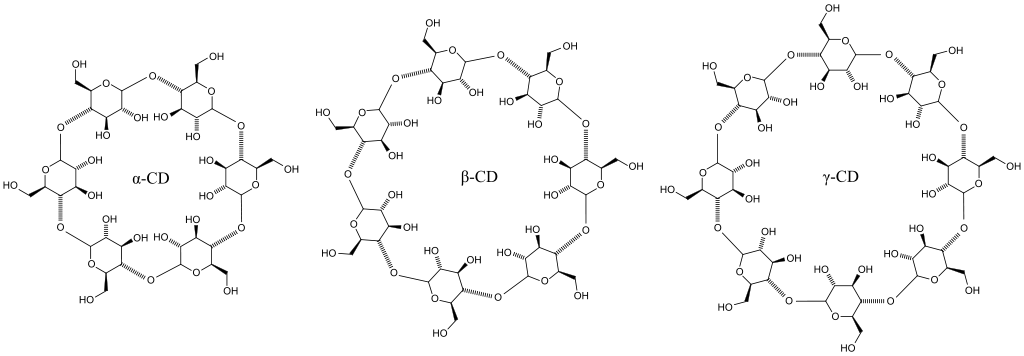The key difference between clathrates and cyclodextrin is that clathrates consist of a lattice that can trap or contain molecules, whereas cyclodextrins are a family of cyclic oligosaccharides that consists of a macrocyclic ring of glucose subunits.
Clathrate compounds are a type of chemical compound that consists of a lattice that can trap or contain molecules. Cyclodextrin compounds are a family of cyclic oligosaccharides that consists of a macrocyclic ring of glucose subunits.
CONTENTS
1. Overview and Key Difference
2. What is Clathrate
3. What is Cyclodextrin
4. Clathrates vs Cyclodextrin in Tabular Form
5. Summary – Clathrates vs Cyclodextrin
What is Clathrate?
Clathrate compounds can be described as a type of chemical compound that consists of a lattice that can trap or contain molecules. This word has the Latin meaning “with bars, latticed.” Most clathrate compounds tend to be polymeric compounds that can completely envelop the guest molecule. However, in the modern use of clathrates, we can observe host-guest complexes and inclusion compounds.

Figure 01: The Chemical Structure of Clathrate Xenon-Paraquinol
According to the definition given by the IUPAC, clathrate compounds are a type of inclusion compounds having the ability to hold a guest molecule in a cage that is formed by the host molecule or by a lattice of host molecules. There are many molecular hosts we can use this name for – for example, calixarenes and cyclodextrins. Moreover, some inorganic polymers such as zeolites are also clathrate compounds.
We can observe that most clathrate compounds are derived from organic hydrogen bond frameworks, which are prepared from molecules that can self-associate through multiple hydrogen-binding interactions.
What is Cyclodextrin?
Cyclodextrin compounds are a family of cyclic oligosaccharides that consists of a macrocyclic ring of glucose subunits. These subunits are joined together through alpha 1,4-glycosidic bonds. Cyclodextrin compounds are typically produced from starch through enzymatic conversion. Generally, these substances are useful in food, pharmaceutical, drug delivery, chemical industries, agricultural industries, environmental engineering, etc.

Figure 02: Some Examples of Cyclodextrin Compounds
Cyclodextrin compounds contain five or more alpha-D-glucopyranoside units that are linked from 1 to 4, in a similar way to that of amylose. Typically, there are a number of glucose monomers that range from six to eight units per ring. This creates a cone shape.
When considering the applications of cyclodextrins, these act as ingredients in many different approved medicines such as hydrocortisone, prostaglandin, nitroglycerin, itraconazol, and chloramphenicol. Moreover, beta-cyclodextrin is important in chromatography to produce a stationary phase for HPLC instruments. Furthermore, cyclodextrin is useful in producing alcohol powder by encapsulating ethanol, and it can also bind fragrances.
What is the Difference Between Clathrates and Cyclodextrin?
Clathrates and cyclodextrins are important organic compounds. The key difference between clathrates and cyclodextrin is that clathrates consist of a lattice that can trap or contain molecules, whereas cyclodextrins are a family of cyclic oligosaccharides that consists of a macrocyclic ring of glucose subunits.
The below infographic presents the differences between clathrates and cyclodextrin in tabular form for side by side comparison.
Summary – Clathrates vs Cyclodextrin
Clathrate compounds are a type of chemical compound that consists of a lattice that can trap or contain molecules. Cyclodextrin compounds are a family of cyclic oligosaccharides that consists of a macrocyclic ring of glucose subunits. Therefore, key difference between clathrates and cyclodextrin is that clathrates consist of a lattice that can trap or contain molecules, whereas cyclodextrins are a family of cyclic oligosaccharides that consists of a macrocyclic ring of glucose subunits.
Reference:
1. “Clathrate.” Encyclopædia Britannica, Encyclopædia Britannica, Inc.
2. “Cyclodextrin.” An Overview | ScienceDirect Topics.
Image Courtesy:
1. “Xenon-paraquinol (JAMKEN) clathrate” By Smokefoot – Own work (CC BY-SA 4.0) via Commons Wikimedia
2. “Cyclodextrin” By Stanisław Skowron – own work – shape of single monomers from work of Bartosz Marcin Kojak, (CC BY-SA 3.0) via Commons Wikimedia
ncG1vNJzZmivp6x7pbXFn5yrnZ6YsqOx07CcnqZemLyue9ahmK1lmah6tbTEZpuinpaav6a6wp5km52krLKmuoyco5qsmKeutbHSZpinnF2YxqS4zp2csayinrtw